Pick Up, Throw Down: We Compare the 2014 Silverado vs. F-150, Ram
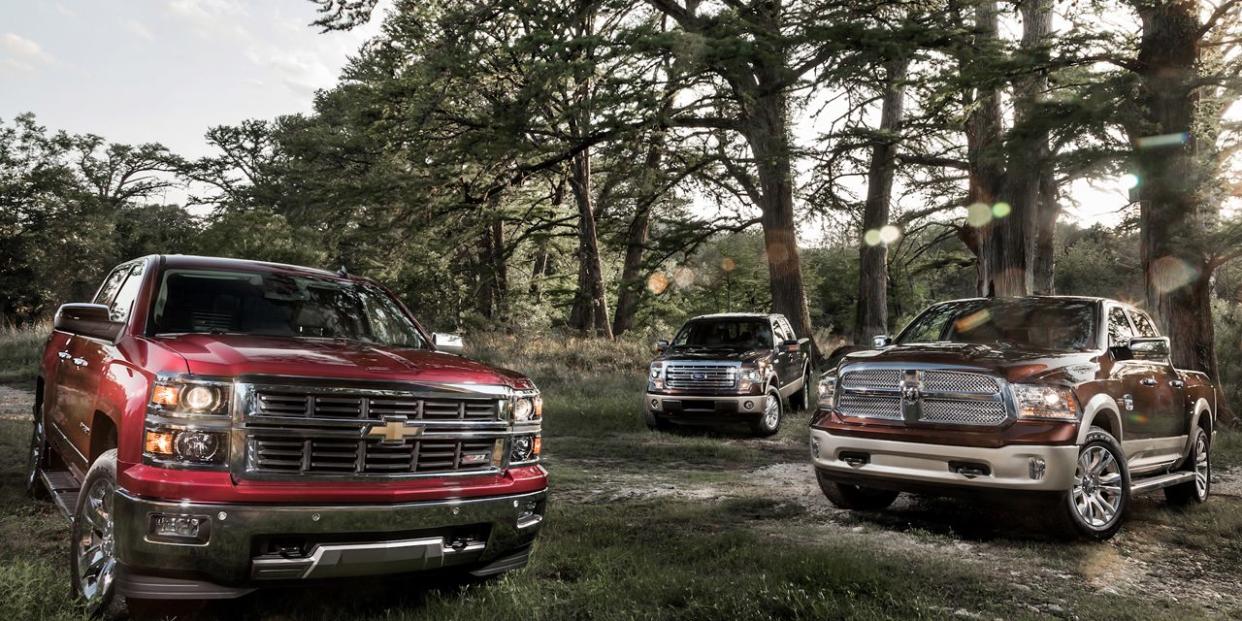
From the September 2013 Issue of Car and Driver
TESTED
You know who simply loves Texas? Swine, that’s who.
Well, feral swine to be more specific. Oh, and pickup-truck drivers, of course. They also love Texas. The one-time independent republic is overrun with both. Truckmakers can’t seem to agree on exactly what proportion of pickups sold is delivered in Texas, except to acknowledge that it’s a truck-load of ’em. Chevrolet estimates that one in six new full-size pickups is sold in Texas, while Ram reckons it’s more like one in five. Either way, those two big players, along with Ford, are so fond of Texas shoppers that each makes some variety of Texas-specific edition of its truck.
According to a 2012 study by Texas A&M University, the feral hog population in the state is somewhere between 1.8 million and 3.4 million. These crafty omnivores are highly adaptable descendants of escaped domesticated pigs, of wild Eurasian boars, and of a hybrid of multiple sources of swine stock. They are unusually fecund; sows begin breeding at six to eight months of age and have two litters of about four to eight piglets every 12 to 15 months. They will live almost anywhere. They eat almost anything. They will damage just about any environment they encounter. A full-grown adult weighs in at between 150 and 400 pounds. And they have a quite high probability of being shot.
They are, then, fairly typical Americans.
The country’s population of pickups has exploded during roughly the same 30-year time period as the wild pigs’ boom. But in contrast to the wild swine, this species has become more and more domesticated with each generation, to the point that the current litter of trucks has an almost minivan-like obsession with family-friendly doodads. (A heated steering wheel? That’s like some kind of New-York-City truck!)
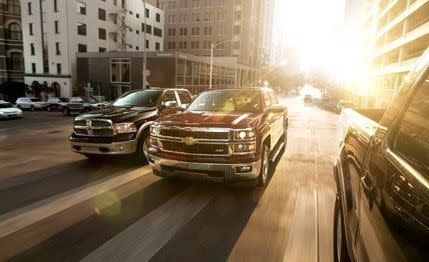
And so it was with all of this in mind that we traveled to central Texas to sample these three not-so-little piggies on their home turf. Well, that and the fact that Chevrolet happened to be unveiling its new Silverado to the automotive press in San Antonio (because Texas!). The introduction of the all-new Silverado was the impetus for this gathering.
From the moment the 2014 Silverado was unveiled at this year’s Detroit auto show, it’s drawn fire for looking too similar to the outgoing model. How’s that for changed expectations in the pickup market? We, however, have no problem with a truck that looks like a truck, even if it happens to look like a truck used to look. We specified the volume model of the lineup, which is a four-door version powered by the 5.3-liter gen-five small-block V-8. A 4.3-liter V-6 and a 6.2-liter V-8 also will be offered. This new pushrod 5.3 comes with fuel-saving cylinder deactivation, direct injection, and variable-valve timing.
The new-age small-block is Chevy’s biggest play for improving fuel economy, a modern priority even among these heavy drinkers. Our 4x4 version is rated by the EPA at 16 mpg in the city and 22 on the highway, one mpg up in both tests over the outgoing 5.3-liter–powered Silverado with the same six-speed automatic.
Other than that, the Chevy has no standout technical feature like the F-150’s turbocharged and direct-injected V-6 or the Ram’s adjustable-height air springs. On first look, then, it appears to be as mechanically conservative as its blocky styling suggests. Our ruby-red example came with the LTZ and Driver Alert packages, to highlight most of the Chevy’s new toys, and carried a $50,755 price tag.
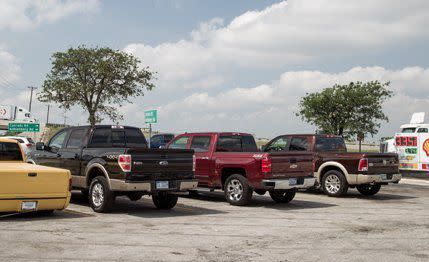
Ford insisted on entering this contest with its optional turbo V-6 ($1095), which the company views as an alternative to conventional V-8s. We asked for a truck with the company’s most popular engine and, according to Ford, the EcoBoost V-6 slightly outsells the 5.0-liter V-8 available in the F-150. And, indeed, the turbo V-6 makes V-8 horsepower—10 horses up on Chevy’s 5.3 and not much less powerful than Ram’s 5.7-liter Hemi. By now you should know that this EcoBoost prioritizes Boost over Eco. The EPA rates the Ford’s fuel economy even with the Ram’s and slightly worse than the Chevy’s. That all three of our trucks averaged 13 mpg over 500 miles of mixed terrain indicates two things: We used full throttle more frequently than was strictly necessary, and the EcoBoost V-6 is like a V-8 in essentially every respect, except it doesn’t sound as good. Despite its optional engine, our Lariat-level 4x4 SuperCrew F-150 was the cheapest truck in the test at a not-at-all cheap $49,725.
The Ram 1500 is our reigning full-size pickup champ. And the Ram folk loaded up a brown-and-tan Ram 1500 Laramie Longhorn Edition Crew Cab to the tune of $55,390, including the Hemi V-8, optional air springs ($1595), and enough cowboy filigree that even the “cowboy” from the Village People might consider it a bit flamboyant.
The updated version of the Texas-built Toyota Tundra was not available in time for this comparison.
In honor of the wide-ranging usage patterns of modern pickup trucks, we steered clear of the cattle-ranch and rodeo clichés and trundled around in the sea of strip malls that is outer San Antonio. We got stuck in impossibly confined parking garages in Austin’s hipster-filthy South Congress neighborhood, endured a lifetime’s worth of Country Music Television at the Buckhorn Bar and Grill in rural Leakey—where nothing appears to have ever been wet enough to leak—and ate barbecue at a gun store/taxidermy shop in Uvalde.
We never did see a wild boar, by the way.
As equipped, the Ram 1500 Longhorn is an assault on the senses. Its chocolate-and-nougat exterior is an acquired taste. Its interior leather stench is strong enough to mask any other smell you might introduce into the cabin.
Its fat-as-a-baseball-bat steering-wheel rim is designed for uncommonly big mitts, though the Ram’s relative lack of headroom means its perfect customer is a strangely proportioned fella. And, of course, there are filigree flourishes all over the thing, including on the faces of the secondary gauges and the trim on the glove box and the floor mats. There are more of these tramp stamps on display here than at Daytona Spring Break.
It’s ironic, too, since the Ram is in some ways the most demure of the bunch. Its ride is pure old-school Cadillac. And we mean that in the most complimentary way. It has none of the jitters normally associated with pickups. Combined with trusty, natural-feeling steering responses, the Ram is the long-haul truck of choice here.
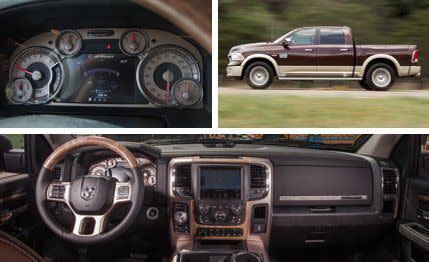
At one measly pound short of three tons, the Ram is 171 pounds chunkier than the Ford and a flab-tastic 394 more than the Chevy. This weight is revealed in just about everything the Ram does. It is a beef-witted lunk. The Ram’s Hemi is the only engine here with nearly 400 horsepower. Yet, it’s the only one that can’t break seven seconds to 60 mph. It’s the slowest through the slalom. And, at 197 feet, it uses up 19 more feet of pavement to stop from 70 mph than the Chevy does.
Our Ram, equipped with a 3.21:1 axle ratio, had the lowest gross vehicle weight (6800 pounds) and gross combined weight (12,100) ratings of the three by a considerable margin. Opting for one of the Ram’s shorter axle ratios (3.55 or 3.92:1) will increase its combined ratings. But that long gear and the truck’s eight-speed automatic are contributors to its serenity at speed.
Up even Texas Hill Country’s shallower grades, that eight-speed ZF gets awfully busy shuffling between gears, trying to keep the Hemi from shotgunning fuel. But at least those shifts are smooth. All things considered, this is an awfully nice vehicle, finishing only one point behind the Ford even though it took a two-point hit on price. Avoid the Longhorn version and you’ll save more than $3000. You won’t have that baseball-glove leather to perfume the cabin but, based on our experience, you’ll still get a truck with exceptional fit and finish, roomy rear quarters, and a relaxed demeanor. Now that’s a cowboy Cadillac.
The Ford F-150 is the oldest truck here. In fact, it’s due for a rework next year. But when one of our team climbed out and said it felt old, we thought he was just crabby because he couldn’t expense the stuffed bear we saw at our lunch spot. However: From the moment you hop way up into the cabin—it was the one truck here without side steps—and close the door . . . oh, wait, why is the door flapping like that? The same thing happens when you close the hood; the attached front grille jiggles in a way so shocking that, if you’re like us, you’ll open the hood and slam it another time just to see it happen again. And again. Others will wince.
It doesn’t necessarily mean that the Ford is cheap. It doesn’t mean the thing will be any less durable than if it were less flappy. But it sure doesn’t leave you with a high-quality impression, either. And, compared with the other two trucks, the F-150 rides a little more like an old truck. Jittery. Shaky.
While the F-150 was once the standard bearer for luxurious truck interiors, the other two have caught and surpassed it. Oh, it’s pleasant enough in this Lariat-level trim, but it’s not cowboy fancy. If that’s what you want, might we direct you to Ford’s King Ranch edition which is, well, a lot like the Ram’s Laramie Longhorn but slightly less silly. And its steering is what once passed for decent in pickup trucks. But by today’s standards, it lacks feel and allows the truck to wander on the highway.
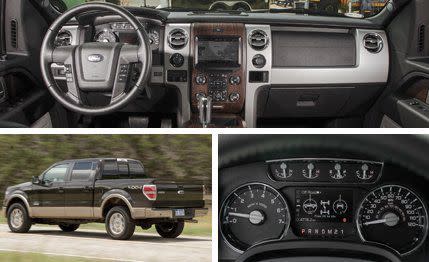
So how did this vehicle finish ahead of Ram, even if by only one point? Well, mostly on the strength of its powertrain. Perhaps you do not give a boar’s buttock about the rumble of a V-8. Further, you might not mind the slightly incongruous sound of a turbo whistling away under the hood of your gasoline-powered pickup. Then this smooth and torque-endowed engine might just be for you. So effortlessly grunty is this engine around town that it makes the big-displacement Hemi feel comparatively high-strung. Its six-speed automatic transmission is easily the test’s best. Its shifts are as slick as bacon fat, and it isn’t forever rooting around for a different gear. The F-150 is a half-second quicker to 60 mph than the Chevy and almost a full second quicker than the Ram. It’s a difference you feel on the road.
While the interior might not impress quite the way it once did, it’s a sensible place to be with good sightlines, huge side mirrors, and a shockingly commodious rear seat. The Ford F-150: Best-Selling Truck in America.
As it turns out, the 2014 Chevy Silverado’s killer technology is simply not being a fat ass. Okay, at 5605 pounds, the Chevy isn’t exactly a flyweight. But it’s more than 200 pounds less massive than the Ford and almost 400 lighter than the portly gentleman of the group, the Ram. The Silverado’s relative slimness isn’t new. When we last gathered these three trucks in 2009, the Silverado was 300 and 340 pounds lighter than the Ram and Ford, respectively.
That sort of weight advantage helps the Silverado stomp all comers in braking performance. With the smallest brake discs, the Chevy stopped from 70 mph in 178 feet, compared with the Ford’s 189 and the Ram’s 197. The Chevy was only 0.2 mph behind the Ford through the slalom. And we suspect its relative lightness contributed to its generally wieldy demeanor. It handles more like a big car than a big truck. When properly tuned, it turns out, a conventional leaf-spring rear suspension can deliver best-in-class handling. The new electric-assist steering sets the standard for accuracy in the class. The 5.3-liter V-8 feels stronger than the more powerful Hemi, and its cylinder deactivation system is utterly imperceptible in operation. A clunkiness on the 1-2 shift is the Silverado’s only powertrain demerit. At higher speeds, the transmission shifts beautifully.
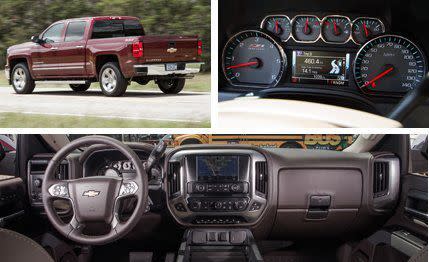
That the steering wheel is set slightly too far inboard is one of our few gripes with the Chevy’s new interior. It’s a modern, straightforward design, rendered in quality materials. Our LTZ-level truck came with a vibrant eight-inch touch screen with a simple, elegant presentation of Chevy’s MyLink infotainment system. We appreciate that we can enter full addresses without having to go through a series of menus for state, city, and street names. Unfortunately, its processing speed trailed those of the Ford and Ram. But the cabin itself was quiet and comfortable thanks in part to hydraulic body mounts and fully lined wheel wells. Our sound meter says the Silverado is only as quiet as the other trucks, but apparently our ears found the sounds that do make it into the cabin more agreeable than those of the other two.
Our truck’s Driver Alert package ($845) includes lane-departure warning, forward-collision alert, front and rear parking assist, and a driver’s seat that vibrates. All of this stuff works, and we would pay for none of it. But that’s us. We love the lineup of three USB sockets, two 12-volt power points, and a 115-volt outlet along the bottom of the center stack. And we also love the CornerStep rear bumper, which incorporates a foothold in each rear-bumper corner and a handy hole on the top of the bed walls. This is a far more elegant solution for climbing into the bed than Ford’s fold-down rear step and retractable handhold. That Chevy cribbed this feature from its own departed Avalanche is no shame.
The Silverado is a clear-headed reworking of the pickup truck. It brings a level of sophistication and technology to the breed without sacrificing capability. We reckon even non-Texans might just like it, too.


('You Might Also Like',)

